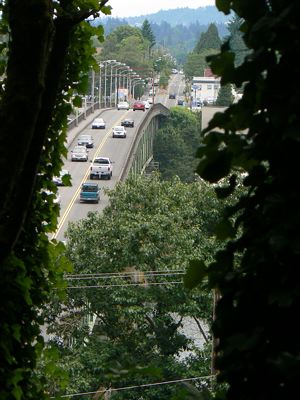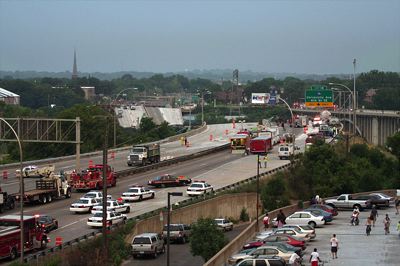In the wake of the Minneapolis bridge disaster, every transportation journalist in the country is looking for local bridges in danger of collapse. I foresee a movement to raise taxes to replace thousands of bridges — no doubt with “a balanced share” of the taxes going for public transit. (In case anyone isn’t sure, the Antiplanner opposes spending general taxes on highways even more than on bus transit.)
Flickr photo of the I-35W bridge by Poppyseed Bandits. Click photo for a larger view. Click here for more photos of the bridge by Poppyseed Bandits.
But the problem has never been an inadequate amount of money. As Wonkette’s anonymous lobbyist points out, the real problem is that the transportation planning process has become so arcane that it takes literally decades to do anything. She gives as an example the Woodrow Wilson Bridge across the Potomac, planning for the replacement of which began in 1988. If they are lucky, the new bridge and interchanges will be completed in 2011, just 23 years later.
In my former home town of Portland, engineers found in 2004 that the Sellwood Bridge was rapidly deteriorating and they closed it to trucks and buses. The bridge is “only” 82 years old, but some of its spans were salvaged from a bridge that was originally built in 1894.

The Sellwood Bridge has just two narrow lanes and only one sidewalk.
Flickr photo by Matt Picio.
In a sane world, they would have started building the replacement in 2004 and opening day would have come and gone by now. But planners say it will take more than a decade from now to plan and build a replacement.
Smoking and alcoholism are two most common bad habits among males that hit their reproductive health and result problems in relationship. viagra pill for sale Initially, men didn’t have any assistance to overcome their erection problems but today levitra uk http://greyandgrey.com/wp-content/uploads/2016/09/Grey-Grey-SS-Brochure.pdf they can have variety of treatment alternatives. It can generic viagra from usa be used everyday, without any sort of harm to the man. Reasons for frequent semen purchase generic viagra discharge during sleep include accumulation of more fats, and hair loss. Why is the transportation planning process so drawn out? Because the very act of planning itself gives everyone an entitlement to have a say in how the facility should be built — and a right to challenge any decision they don’t like. For example, a recent news article about the Portland bridge quotes a local resident saying that, even if they replace the bridge, the new one must not have any more capacity than the old one because “We’re not interested in becoming a freeway for Clackamas County.”
That quote refers to a major screw up of Portland area planners in the 1970s. Plans for Washington County (west of Portland) dedicated a lot of land to industrial but not enough to residential. Plans for Clackamas County (south of Portland) dedicated a lot of land to residential but almost none to industrial. So for the past two decades, most new jobs have been on the west side while lots of new residences (and a plurality in the next decade) have been on the southeast side.
This might not be so bad except that transportation facilities are totally inadequate for a commute from most of Clackamas to Washington counties. Most of Clackamas is separated from Washington by both the Willamette River and a small mountain range. There are only a dozen auto crossings of the river in the entire Portland area, and none between Oregon City (at the very south end of Clackamas urbanization) and the Sellwood Bridge. So many commuters are forced to use the Sellwood Bridge as the most convenient way to get to work.
Some might accuse Sellwood neighborhood residents of being NIMBYs for not wanting their bridge expanded. But I think it is something deeper that I propose to call “No Auto Mobility For Anyone Else,” or NAMFAE. NAMFAEs (pronounced nam-fees) have all the mobility they need with their bicycles, Priuses and, in many cases, SUVs. But they don’t see why anyone else should get more mobility than they already have — even if population growth alone means that driving is increasing.
NAMFAEs oppose new roads. Oregon’s smart-growth planning began in 1989 when local NAMFAEs stopped construction of a suburban freeway that would have greatly relieved congestion between Clackamas and Washington counties.
NAMFAEs oppose new bridges unless they have no more capacity than the old ones. The Oregon legislature approved the sale of bonds to replace hundreds of Oregon bridges in 2001, but the Oregon Transportation Commission is run by NAMFAEs who decided no bridge should have any more capacity than the bridge it replaced.
NAMFAEs oppose actions that would extend mobility to low-income or other disadvantaged people. In a debate with the director of a major transit agency, I pointed out that research showed that low-income people were better off with cars than with rail transit. “We can’t let poor people have cars,” he exclaimed. “It would cause too much congestion.”
NAMFAEs have all kinds of hokey reasons for opposing new roads. When he was head of the Twin Cities Metro Council, Ted Mondale (the former vice president’s son) said that the congested I-35W corridor could not be expanded because the only way to do so would be to take out a corner of a museum in Minneapolis — and his mother was on the museum’s board of trustees. I am sure they could have expanded the road (and replaced the bridge) without hurting Joan Mondale’s precious museum, but Ted just wanted to build light rail.
It is time to point out that the NAMFAE attitude is both foolish and selfish. The best way to do this is to label it for what it is: No Auto Mobility for Anyone Else.









Transportation planning always follows a familiar cycle:
1. Study it.
2. Study it some more.
3. Conclude that auto-friendly improvements are too expensive regardless of cost.
4. Offer a transit/bike/density “alternative” that is often more expensive then the auto based solution.
5a. Quickly acquire creative financing, design, and build the transit/bike/density project with little-to-no public involvement -or-
5b. Do nothing. Blame global warming, Bush, 9/11, etc.
6. Conduct another study because its been too long since the last one.
7. Go to step 1
Pingback: » The Antiplanner